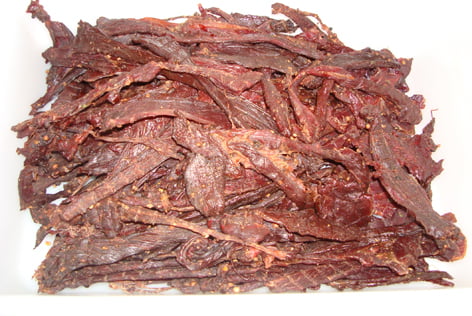
The basic processing directions for making either product are the same. Only the seasoning is different. Beef is suggested, but any meat can be used. Pork, or any meat that may contain trichinae, should be heated until the internal temperature is at least 160°F (71°C).
The following jerky seasoning formulas are not true marinades, and they are not true brines either. They are somewhere in-between. Nevertheless, these cures work very well for jerky, and they can be used as models to make countless other jerky seasoning formulas.
Seasoning for 5 LBS. (2.25 KG) of Sliced Meat
- 3 Tbsp. (45 ml) Bradley Cure — any flavour (Do not use more than this amount.)
- 4 tsp. (20 ml) ginger powder
- 4 tsp. (20 ml) garlic powder
- 4 tsp. (20 ml) pepper, black
- 1 tsp. (5 ml) liquid honey marinade
- 1 1/2 cup (360 ml) orange juice
- 6 Tbsp. (90 ml) soy sauce
- 1/2 Cup (960 ml) cold water
Note: If the meat weighs either more or less than 5 pounds (2.25 kg), the amount of cure mix applied must be proportional to that weight. For example, if the weight of the meat is 2 1/2 pounds (1.15 kg), then each ingredient, including the Bradley Cure, needs to be cut in half.
Preparation and seasoning
- Begin with hunks of meat, rather than with meat that has been cut into steaks or chops. (Steaks and chops are cut across the grain of the meat. This makes them unsuitable for jerky.)
- Chill the meat thoroughly. Cold meat is easier to cut, and bacterial growth is retarded.
- Trim the fat from the meat. It is impossible to remove the streaks of fat that are marbled into the meat, but you should remove all fat that can be removed easily.
- Use a long slicing knife or an electric meat slicer to slice 1/4 inch (7 mm) thick strips. The strips should be 1 to 2 inches (2.5 to 5 cm) wide. The meat must be cut with the grain, not across the grain. If the meat is cut across the grain, it will be too fragile after it dries. You can determine if the strip has been correctly cut with the grain by pulling on the ends of the strip. If it has been properly cut with the grain, the strip will stretch; if not, the muscle fibers will separate, and the strip will tear.
- Chill the meat again while preparing the seasoning mixture.
- Immediately after these instructions on how to process jerky, there are two jerky recipes: California Jerky and Wild West Jerky. Select and prepare one of these seasoning blends. Stir the seasoning blend well until all ingredients are dissolved. Chill the mixture well. Add the meat strips and stir them from time to time, especially during the first few hours of curing. Refrigerate overnight.
- During the morning of the second day, use a colander (or the like) to drain the curing liquid from the meat. Do not rinse!
Drying and smoking the jerky
- Place the strips on jerky racks. A thermometer is not required for beef, pork, or any other kind of meat if the suggested high temperatures and long processing times are followed. You may use a common smoker with a heat source inside. To facilitate drying, the smoker chimney damper should be fully open.
- Smoke at 140°F (60°C) for the first 2 hours
- Raise temperature to 160°F (71°C), and smoke for 2 or 3 hours.
- Raise temperature to 175°F (80°C) — for poultry, raise the temperature to 185°F (85°C) — and continue to dry with no smoke until done. This final drying and cooking step will require about three hours. When the jerky is done, it will be about half the thickness of the raw jerky, and it will appear to have lost about 50% of its weight. The jerky will not snap when it is bent, but a few of the muscle fibers will fray. If the jerky is dried until it snaps when it is bent, the jerky will have a longer shelf life, but it will not be as tasty. Let the jerky cool to room temperature, and either freeze or refrigerate it.
Note: If the salt taste is too mild, the next time you make this product, add about 1 teaspoon of salt to the ingredients list. If the salt taste is too strong, reduce the amount of Bradley Cure by about 1 teaspoon.
